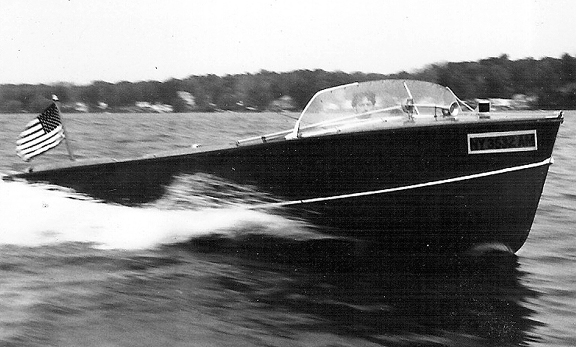
Freddie Curry is still the owner of the only 22 foot double cockpit Morehouse Inboard ever built: photo- george zeth
A BRIEF HISTORY by Duncan Remington and Dick Sherwood, ACBS Rudder, Spring, 1999
Boat Show Featuring Morehouse
Boats click here
revised by George Zeth, April,
2002
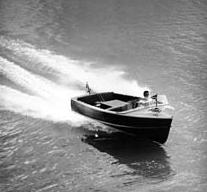 In 1905, George Morehouse was working
at a summer restaurant known as the Wayne Pavilion located on the west side
of Cayuga Lake (the largest of the eleven Finger Lakes in upstate New York)
and next to what is now Cayuga Lake State Park. It was not far from the village
of Seneca Falls and a short distance from what was once advertised as the longest
bridge in the United States, the mile-long planked toll bridge across the northern
end of Cayuga Lake. According to his daughter, Betty Morehouse Zeth, “he needed
something to do in the winter” so he did odd carpentry jobs, some of which included
the building of small boats. But it wasn’t until after he married Martine Christensen
in 1908 that he seriously took up the study of boat design, building his first
boat in 1913.
In 1905, George Morehouse was working
at a summer restaurant known as the Wayne Pavilion located on the west side
of Cayuga Lake (the largest of the eleven Finger Lakes in upstate New York)
and next to what is now Cayuga Lake State Park. It was not far from the village
of Seneca Falls and a short distance from what was once advertised as the longest
bridge in the United States, the mile-long planked toll bridge across the northern
end of Cayuga Lake. According to his daughter, Betty Morehouse Zeth, “he needed
something to do in the winter” so he did odd carpentry jobs, some of which included
the building of small boats. But it wasn’t until after he married Martine Christensen
in 1908 that he seriously took up the study of boat design, building his first
boat in 1913.
His
first two boats were fairly unimpressive and conventional flat-bottomed, pointed
craft with broad sterns, built in the basement of his home. Subsequently, he
built and sold several boats, earning $25.00 for flat-bottomed designs and $35.00
for round-bottomed ones. Having purchased the Wayne Pavilion in 1919 and renaming
it the Grandview Inn, he eventually established a boat livery in 1925 next to
the restaurant. Much of the boat production (up to twelve boats per year) was
aimed at outfitting this new business. For several years, it was the restaurant
that supported the boat business.
George and Martine had two sons; Richard (Dick), born in 1909 and Robert (Bob), born in 1918. By 1925 both boys were helping their father build 14-foot rowboats, boosting winter production to 25 boats per year. When Bob was graduated from high school in 1936, he joined his father and older brother in full-time boat building, producing three models of boats and pushing production up to 50 craft per year. From 1930 to 1937, their workshop was in the shore-side livery until it was moved into the basement of the newly erected restaurant, which offered full service breakfasts and dinners for up to 200 guests. The restaurant featured a soda fountain with homemade ice cream and was renamed “Morehouse’s”. In 1937 George officially named the boat building operation the “Morehouse Boat Manufacturing Company”.
George Morehouse died in 1942, leaving his business to his wife who had her two
sons run the livery and boat company while she ran the restaurant. World War II
put serious boat building on hold as Bob went into the service and Dick went to
work on defense matters at the nearby Seneca Ordnance Depot. The Depot’s
proximity to Cayuga Lake did allow Dick to oversee the continued production of
some small boats during the war.
|
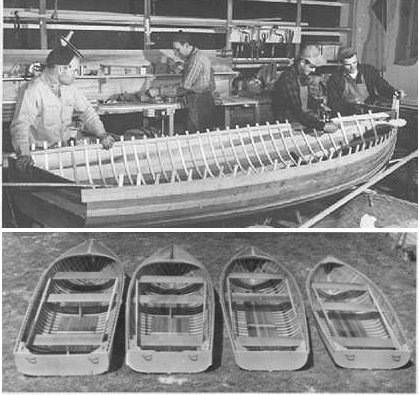 |
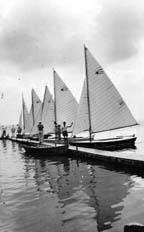 Except for the war
years, the Company built Comet sailboats from 1938-51 and Lightning sailboats
from 1946-51. Wherever they went, Morehouse sailboats were recognized as
formidable competition. Morehouse Comets won Central New York State
Championships for five years in a row and one took a second-place in national
competition. Lightning #1903, sailed by Stu Anderson, finished fifth in the 1961
World Championships held in Milford, Connecticut - it was the oldest boat
entered.
Except for the war
years, the Company built Comet sailboats from 1938-51 and Lightning sailboats
from 1946-51. Wherever they went, Morehouse sailboats were recognized as
formidable competition. Morehouse Comets won Central New York State
Championships for five years in a row and one took a second-place in national
competition. Lightning #1903, sailed by Stu Anderson, finished fifth in the 1961
World Championships held in Milford, Connecticut - it was the oldest boat
entered.
In 1947, Morehouse began work on an inboard utility design, building their first in 1948. In 1950, two sizes of inboards were introduced, 18-foot and 20-foot models, with construction similar to that of the outboards. Power for the inboards was provided by Chris-Craft (Hercules) engines, normally the 95 horsepower six-cylinder versions, although a few four-cylinder engines were also installed. One unique 22-foot inboard was built on special order for Phil Westcott Sr., owner of the Westcott Rule Company, Incorporated of Seneca Falls. It was configured with two cockpits (seats) forward, a utility layout aft and was powered by a 145 horsepower Chris-Craft six. This unusual craft is still in the Cayuga Lake area awaiting hull repair after colliding with an unlighted buoy. A total of 39 inboards were built between 1947 & 1956, developing a reputation as safe, comfortable boats for fishing or family fun. With larger and more powerful motors available, 16’, 17’ and 18’ strip-planked outboards were introduced between 1955 & 1959
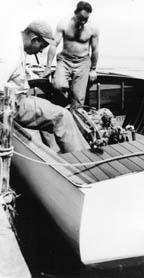 The
peak year of Morehouse boat production was 1956, with twelve different models on
display in the new full-service showroom that was once the restaurant. A total
of 300 boats (one per workday with a labor force of eight) came out of the
factory. Sizes ranged from 12 to 20 feet with the 14-foot fisherman one of the
most popular models produced. Hundreds of 14-foot regulars and 14-foot
Fishermans were shipped to boat liveries for livery use. Although Morehouse
boats became well known in central New York State, buyers also came from
throughout the Northeast, the Great Lakes region, Pennsylvania and Tennessee.
Other than the factory on Cayuga Lake, the Hutchinson Boat Works in Alexandria
Bay, New York was believed to be the only dealer for Morehouse boats. This
arrangement evolved solely because the Thousand Islands region of the St.
Lawrence River was a favorite fishing area of the Morehouse brothers. Recent
information suggests the dealer network was extensive in New York State and
possibly beyond its borders.
The
peak year of Morehouse boat production was 1956, with twelve different models on
display in the new full-service showroom that was once the restaurant. A total
of 300 boats (one per workday with a labor force of eight) came out of the
factory. Sizes ranged from 12 to 20 feet with the 14-foot fisherman one of the
most popular models produced. Hundreds of 14-foot regulars and 14-foot
Fishermans were shipped to boat liveries for livery use. Although Morehouse
boats became well known in central New York State, buyers also came from
throughout the Northeast, the Great Lakes region, Pennsylvania and Tennessee.
Other than the factory on Cayuga Lake, the Hutchinson Boat Works in Alexandria
Bay, New York was believed to be the only dealer for Morehouse boats. This
arrangement evolved solely because the Thousand Islands region of the St.
Lawrence River was a favorite fishing area of the Morehouse brothers. Recent
information suggests the dealer network was extensive in New York State and
possibly beyond its borders.
The mid-fifties saw the introduction of fiberglass and aluminum in small craft hull designs, making the high labor content of planked construction unacceptably expensive. In an attempt to remain competitive, the Company bought rough-molded birch hulls in 14, 15, 16 and 18-foot lengths for finishing (adding decks, trim and hardware) at the Morehouse shop. These hulls were imported from the Industrial Shipping Company, Ltd. of Mahone Bay, Nova Scotia and sold by Cotton-Hanlon Lumber Company in Odessa, New York. But this only staved off the inevitable for a short time, and in 1961-62 Morehouse boat production was discontinued. The Company remained in operation selling and servicing boats and motors of several manufacturers becoming the largest full-service marina in the area offering expanded docking and boat storage facilities until 1978 when the doors were closed for the last time. In the meantime, Dick Morehouse sold his share of the Company to Bob in 1967 and devoted his time to the Morehouse Bait Farms. He passed away in 1982, Bob Morehouse died in 1988.
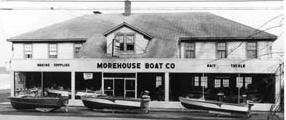 Over the years, several
thousand Morehouse boats were built. A few remain, mostly in upstate New York.
Of the 39* inboards built, 8 are known to have been destroyed, but at least 21
others still exist. Some of the jigs and fixtures used in boat production have
been donated to the Antique Boat Museum in Clayton, New York. The others remain
in the hands of the Morehouse family. The restaurant/showroom building and the
lumber storage building are all that remain of the Morehouse complex. The
Morehouse property was sold to the New York State Department of Parks and
Recreation in 1982. The livery was demolished in 1983 and the manufacturing
plant (old dance hall) was razed in 1993.
Over the years, several
thousand Morehouse boats were built. A few remain, mostly in upstate New York.
Of the 39* inboards built, 8 are known to have been destroyed, but at least 21
others still exist. Some of the jigs and fixtures used in boat production have
been donated to the Antique Boat Museum in Clayton, New York. The others remain
in the hands of the Morehouse family. The restaurant/showroom building and the
lumber storage building are all that remain of the Morehouse complex. The
Morehouse property was sold to the New York State Department of Parks and
Recreation in 1982. The livery was demolished in 1983 and the manufacturing
plant (old dance hall) was razed in 1993.
The last Morehouse boat was built in 1970 long after regular production had ceased. It was, fittingly, like the first, a flat-bottomed craft of 20-feet. This heavy-duty workboat, framed in oak and planked with mahogany plywood, was bought by the State of New York along with other Morehouse properties that became part of Cayuga Lake State Park. This workboat was discovered in a storage building at Sampson State Park in 2001 and returned to the Cayuga Lake State Park facility for public display.
* Recent findings indicate that more than 39 inboards were sold, based on deposit and delivery receipts.
Pictured right: Ford & Nancy Knight's 1954 Morehouse <18' 8cyl.> Pictured left Bob & Teddy Myllymaki's 1954 Morehouse <18' 6cyl 95hp.>
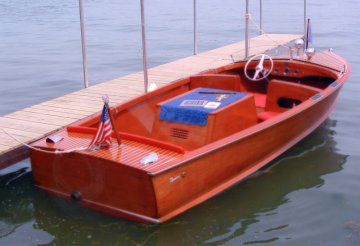 |
 |
| MOREHOUSE BOATS:
TIMELINE 1906 George Morehouse goes to work for William Wayne at Wayne’s Pavilion. Martine Christensen works for Mrs. Wayne in Wayne’s Pavilion kitchen 1908 George Morehouse and Martine Christensen are married. 1909 Richard Morehouse is born. 1913 George Morehouse builds his first boat in the basement of his camp at 2729 Lower Lake Road 1916-18 George and Martine Morehouse operate Wayne’s Pavilion for Mr. and Mrs. Wayne. 1918 Robert Morehouse is born. 1919 George and Martine Morehouse purchase Wayne’s Pavilion and rename it the Grandview Inn. 1920 George Morehouse builds a new home at 2730 Lower Lake Road. 1921 George Morehouse expands the Grandview Inn. 1921-30 George Morehouse builds boats in garage-attached workshop at 2730 Lower Lake Road 1925 George Morehouse builds a boat livery, garage and ice house on north side of Grandview Inn 1927 Betty Morehouse is born 1927-28 George Morehouse builds the Grandview Pavilion dance hall across the street from the Grandview Inn 1929 The boat livery is destroyed by fire 1930 A new
boat livery is built larger to accommodate boat
building. 1931 New boats are introduced for outboard engines. 1931-39 Richard Morehouse operates the Grandview Pavilion. 1936 The
Grandview Inn is demolished. 1937 The Morehouse Boat Company is formed and boat building is moved to The basement of the new restaurant. 1938 The
Red Jacket Yacht Club is founded with headquarters in the restaurant
basement, E. R. Smith is the first Commodore.
1939-45 The Grandview Pavilion is leased to Vern Adams of Auburn for use as a roller skating rink. 1941 George Morehouse, as a founding member, over-sees the construction of the Red Jacket Fire Department. 1942 George Morehouse dies in his home at age 51. 1942-45 Richard
Morehouse works at the Seneca Ordnance Depot and manages the boat
building business. 1942-56 Martine Morehouse leases the restaurant out. 1946 Richard and Robert Morehouse lease and convert the Grandview Pavilion. (roller rink) for full time boat building factory, an addition to the boat livery is a showroom for 10’, 12’and 14’ rowboats, 14’ and 15’ fisherman outboards and Comet and Lightning sailboats.“The lumber storage shed is built behind the factor Became a dealer for Sterling trailers and Sagen boat hoists. 1946-53 Became a dealer for Martin and Chris-Craft outboard engines and Penn Yan boats. 1947-48 The first inboard is built, 18’ 6” w/ 75 HP Gray Marine engine. 1948 Became a dealer for Grumman aluminum canoes. 1949 An inboard shed is built on the waterfront, storage for 12 inboards. 1950’s Rented out 75+ livery boats and canoes. 1950 The 20’ inboard is introduced, a 16’ inboard is offered in a sales pamphlet, none are known to have been built. 1951 Comet and Lightning sailboat production is discontinued . 1952 Planking is changed from straight carvel to bead and cove carvel. 1953 The Company’s largest boat is built, a 22’ inboard for Phil Westcott, Sr. 1955 The 16’ outboard is introduced. 1956 Martine Morehouse sells all property to Richard and Robert Morehouse, the restaurant is closed and remodeled for a boat showroom with fishing tackle, guns and ammunition. “Largest boat production
year with 300+ built, last inboard built.
1957 The 18’ outboard is introduced along with moulded plywood hulls in 14’, 15’, 16’and 18’ lengths 1958 The marina is expanded and a 6 ton hoist is installed on lakefront to ease boat handling, entire front lawn is covered with concrete. “The 16’ outboard is discontinued, becomes a Chris-Craft Cavilier dealer. 1959 The 17’ outboard is introduced. 1960-68 Became
dealer for: Evinrude boats and snowmobiles Aluma Craft, Crosby, Slickcraft, Mirro Craft, MFG and Maritime aluminum and fiberglass boats. Flying Finn and Grady-White wooden boats. OMC inboard/outboards. Homelite outboards. Gator and Shorelander trailers. R&G boat hoists. 1961 The moulded boats are discontinued, proven to be inferior in holding fasteners. 1961-62 The last production boats, the14’ fisherman and 17’ outboard, were built, a few were sold in ‘63 and registered as ‘63s 1963 Floating docks were built in the factory, hand-treated oak, pine and plywood with redwood decking and Styrofoam flotation 1963 Richard Morehouse builds a new home at Morehouse Bait Farms in Canoga, his apartment is gutted for more storage of boats and motors. 1963 Most wooden livery boats are sold off and replaced with 14’ Aluma Craft and Mirro Craft aluminum boats. 1963-65 The marina is enlarged with 1600’ of floating docks, 75 slips for boats 14’ to 30’ in length, the livery harbor is filled in and capped in concrete, a new 4 ton hoist is installed at the waterfront and a new boat livery is built on the north side of the inboard shed. 1967 Richard Morehouse sells his share of the boat company to Robert and devotes his time to the Morehouse Bait Farms. 1970 Robert Morehouse builds the last boat, a 20’ heavy duty work boat of mahogany plywood on oak frames; used for harbor work and delivery of pre-assembled boat hoists. 1972 June flooding from Hurricane Agnes closes the lake for the rest of the season with widespread destruction of boats, docks and hoists. 1974 The fuel shortage causes a decline in the boating industry and business. 1974-78 Cayuga Lake succumbs to weed problems and business declines further. 1978 Robert Morehouse closes the doors for the last time, poor business and failing health. 1978-82 Robert Morehouse sells off remaining stock, builds a new building to house boat building equipment and lumber. 1980 Martine Morehouse dies at age 89. 1982 Morehouse Boat Company complex is purchased by New York State Parks for a new marina and boat launch. “Richard Morehouse dies at age 72 1983 The boat livery, inboard shed, ice house and garage are demolished to make way for the Bridgeport sewer project. 1985-90 New York State restores restaurant/showroom building for use as a recreation center and Park Police office. 1988 Robert Morehouse dies at age 70. 1992 New York State plans to burn the Grandview Pavilion/ boat factory as a fire demonstration, Morehouse family resistance delays the inevitable. 1993 New York State demolishes the Grandview Pavilion/ boat factory site for use as a parking lot. 2000 All that remains of the Morehouse Boat Company complex are the restaurant/showroom building and the lumber storage building, a new boat launch has been built but not the promised new marina. 2001 Some
of the patterns and forms have been donated to the Antique Boat Museum in
Clayton, In the late 1940’s and early
1950’s, Morehouse Boat Company did contract work for several local
businesses including: Humpty Dumpty Toy Company, Seneca Falls - tens of thousands of wood blocks Knight Letter Works, Seneca Falls - display boxes Goulds Pumps Inc. - planed and sized mahogany lumber (foundry pattern shop) to email George Zeth click on the logo. last updated~~~October 30th 2011 |